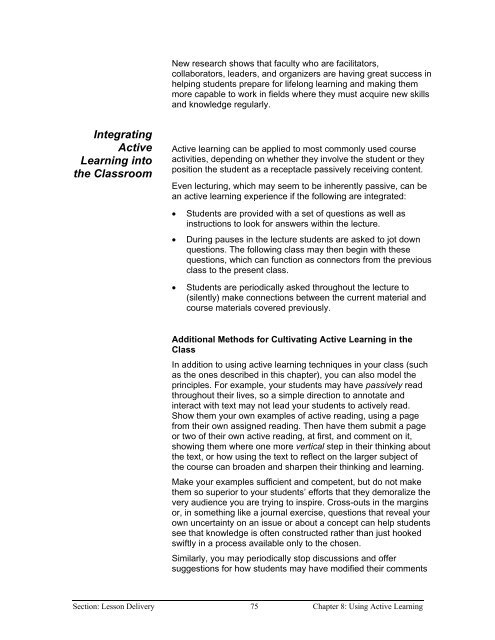Chapter 9 - Instructional Media: Chalkboards to Video - CGISS
Chapter 9 - Instructional Media: Chalkboards to Video - CGISS
Chapter 9 - Instructional Media: Chalkboards to Video - CGISS
Create successful ePaper yourself
Turn your PDF publications into a flip-book with our unique Google optimized e-Paper software.
New research shows that faculty who are facilita<strong>to</strong>rs,<br />
collabora<strong>to</strong>rs, leaders, and organizers are having great success in<br />
helping students prepare for lifelong learning and making them<br />
more capable <strong>to</strong> work in fields where they must acquire new skills<br />
and knowledge regularly.<br />
Integrating<br />
Active<br />
Learning in<strong>to</strong><br />
the Classroom<br />
Active learning can be applied <strong>to</strong> most commonly used course<br />
activities, depending on whether they involve the student or they<br />
position the student as a receptacle passively receiving content.<br />
Even lecturing, which may seem <strong>to</strong> be inherently passive, can be<br />
an active learning experience if the following are integrated:<br />
• Students are provided with a set of questions as well as<br />
instructions <strong>to</strong> look for answers within the lecture.<br />
• During pauses in the lecture students are asked <strong>to</strong> jot down<br />
questions. The following class may then begin with these<br />
questions, which can function as connec<strong>to</strong>rs from the previous<br />
class <strong>to</strong> the present class.<br />
• Students are periodically asked throughout the lecture <strong>to</strong><br />
(silently) make connections between the current material and<br />
course materials covered previously.<br />
Additional Methods for Cultivating Active Learning in the<br />
Class<br />
In addition <strong>to</strong> using active learning techniques in your class (such<br />
as the ones described in this chapter), you can also model the<br />
principles. For example, your students may have passively read<br />
throughout their lives, so a simple direction <strong>to</strong> annotate and<br />
interact with text may not lead your students <strong>to</strong> actively read.<br />
Show them your own examples of active reading, using a page<br />
from their own assigned reading. Then have them submit a page<br />
or two of their own active reading, at first, and comment on it,<br />
showing them where one more vertical step in their thinking about<br />
the text, or how using the text <strong>to</strong> reflect on the larger subject of<br />
the course can broaden and sharpen their thinking and learning.<br />
Make your examples sufficient and competent, but do not make<br />
them so superior <strong>to</strong> your students’ efforts that they demoralize the<br />
very audience you are trying <strong>to</strong> inspire. Cross-outs in the margins<br />
or, in something like a journal exercise, questions that reveal your<br />
own uncertainty on an issue or about a concept can help students<br />
see that knowledge is often constructed rather than just hooked<br />
swiftly in a process available only <strong>to</strong> the chosen.<br />
Similarly, you may periodically s<strong>to</strong>p discussions and offer<br />
suggestions for how students may have modified their comments<br />
Section: Lesson Delivery 75 <strong>Chapter</strong> 8: Using Active Learning
















